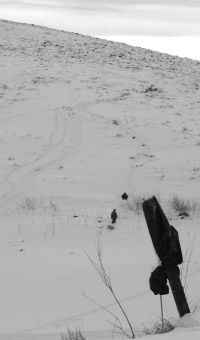| Snow covered mountains throughout Carbon and Emery counties may appear safe, but in reality the dangers are high. With recent percipitation falling on top of already snow covered mountains, the avalanche danger has become severe. When participating in recreational activities in the back country of Utah, use caution and never go alone. |
As spring officially kicks off this week, Carbon County residents will be heading for the outdoors. Although the snow and ice are melting gradually on mountains and reservoirs, residents may find themselves in a dangerous situation.
According to weather experts, layers of snow tell the story of the season’s storms and the density and consistency of each snowfall. When these layers fail to bond, one layer of snowpack slides atop another.
An outdoorsmen crossing above or below a snowpacked slope can cause a layer to break and trigger a slide or an avalanche.
After experiencing a week of rain and snow, Carbon and Emery county mountain areas may be dangerous.
During storms, the fresh snow hasn’t had a chance to settle and bond with the old snow beneath it.
It is recommended that local residents wait at least a day after a storm to travel in avalanche-prone territory.
If snow starts falling heavily while in the mountains, especially at a rate of an inch or more per hour, or the wind starts blowing hard, get to safer ground. It is difficult to predict when an avalanche may occur, so when in doubt, get out.
The steepness of the terrain is also a factor. Avalanches need slopes of 25 to 55 degrees to occur.
Anything less rarely slides and anything steeper doesn’t accumulate enough snow to cause an avalanche.
If by chance an outdoorsman wanders onto an unstable slope and a monsterous roar on a nearby slope or cracks in the snow are spotted, get to safe terrain immediately.
In order to get out of the dangerous area, either backtrack or follow the least-angled terrain available.
If the unsettling noise continues while hiking a trail that’s not on a slope, take it as a warning and stay off and away from tilted terrain.
The following tips may help residents to avoid becoming part of an avalanche and even help them to survive.
•Travel above or below a slope. Remember however, if traveling below a slope in a valley, and an avalanche occurs, the valley may fill up quickly with snow.
•Avoid traveling directly up or downhill from another person. Over 90 percent of avalanche victims trigger the slide that catches them, so stay clear of other’s paths.
•Cross gullies and other avalanche-prone terrain one person at a time and watch other hikers who are also crossing.
•Keep 100 to 200 feet distance between hikers in avalanche-prone country and never rope up. If a slide does occur, fewer people will be swept up in it.
•Carry a compact snow shovel and a probe or ski poles which can be used to escape an avalanche.
If a resident does get caught in a slide, the following information may be valuable.
•Try to get to the side of the avalanche before it accelerates, then grab onto a tree or rock.
•If buried by snow, try to swim atop the snow. When the slide begins to slow down, punch an arm upward so others can locate the spot where the victim is buried.
•Clear an air pocket in front of the face if buried in snow. Don’t wait for the snow to stop sliding because it will set like concrete almost immediately.
As the spring season begins to heat up, snow and ice will begin to melt. This should cause concern to those who are participating in recreational activities in the back countries of southeastern Utah.
Another problem which effects Carbon recreationalists is ice fishing conditions.
In many areas, the ice has become thin and caution should be used when wondering out onto Utah waterways.
In fact, wildlife officials are encouraging anglers to wait until the lakes and reservoirs are completely thawed before participating in any activity atop the water.

